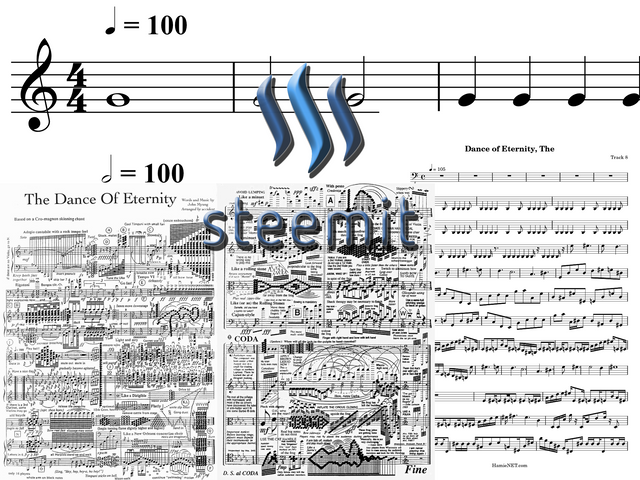Time Signatures in music - why do they matter? What is 4/4 anyway? [my answers]
The past few days I've hit one of my periods of discussing music. A lot of the music that really appeals to me tends to change time signatures a lot. This is not common in most popular music. It is common in things like Progressive Rock, Jazz, and Progressive Metal. I tend to talk about Prog bands quite a bit and I've recently encountered some amusing youtube videos that can actually help with explaining time signatures.

In music there is what is known as a measure. This is essentially a grouping of time. A Time signature specifies what type of NOTE in sheet music is to constitute a BEAT and how many of those should occur per measure.
The number on top when you see it as a fraction is the number of notes, and the number on bottom is the type of note that constitutes a beat.
1 = Whole Note, 2 = Half Note, 4 = Quarter Note, 8 = Eighth Note, 16 = Sixteenth note, 32 = a thirty second note, etc.
In the past it was common to have songs have pretty different time signatures for each song. This was fairly common in classical music as well.
Rock and Roll and Blues
These styles of music tended to focus on 4/4 time. This means four quarter note beats per measure. In fact, you'll find songs that talk about this. It is really easy to dance to, easy for the crowd to learn, and also easy for those not musically inclined to get into. It is also typically a lot easier to perform if you only have to stick with a well known time signature.
See what the Beatles have to say about it...
The lyrics in that talk about a back beat and basically most of the song is actually talking about the 4/4 time signature.
Changing Time Signatures
If you have or ever have the pleasure of jamming with people you'll quickly understand that changing time signatures mid-song increases the difficulty of performing that song significantly. It also can make the song difficult to dance to unless you are familiar with the song. If you know a song then you can dance to it (any song). 4/4 time made it so you didn't really need to know the song in order to dance to it. Most popular music sticks to 4/4 time.
Here is a good video on how to "speak" in odd time signatures...
Insane Progressive Metal Example
I am a big fan of watching Dream Theater. Watching them and listening to them perform melts my mind. As a musician, this is much like me STUDYING dancing and then going to a dance show to watch people that are vastly better than me.
Dream Theater LOVES to change time signatures VERY frequently, as well as keys. This is some of the most complex music I am aware of at this time. I want to show you a Dream Theater song as they perform it LIVE. I am then going to show you a video of a guy doing the same song ala beat boxing and using flash cards to show you the changing time signatures.

Dance of Eternity by Dream Theater Live Scenes From New York.
Now let's check out the beatbox version...


An interesting aspect of music is that a time signature is merely a framework to help describe the actual music and that with syncopation and other variations, what is written in 4/4, for example, can sound like a different time signature. What is important to understand is that music is something beyond what is traditionally taught and understood.
Filling up a chart by the lines on the paper is like painting by the numbers. Sure, you can make a very nice painting by following the numbers and using the techniques developed over the years, but if you want to be your own fish, you have to jump out of school.
The human ear needs time to get used to sounds it is unfamiliar with, but once it does, those new sounds can offer extra dimensions to musical expression. Always be open to sounds that don't appeal to you at first. Given time, even the harshest and oddest sounds can turn pleasurable. This appreciation will then give you a greater choice of musical entertainment and expression.
Yeah, I am very familiar with this. I actually myself do not recognize time signatures unless I'm forced to count them. I just tend to feel the music as a whole. I don't sight read for example. I am slow at it as I was late at life in learning any of that. I am mostly by ear. I can read music... slowly. Once I know a piece I don't need the music. Most things I do play I never had sheet music just learned by ear.
Yet when discussing Time Signatures and complexity of music you and I already know what they are referring to. Yet, to people that do not know the term discussing how amazingly complex something is to people and referring to how often the time signatures change is meaningless.
I viewed this post as simply another tool for music appreciation. It might give people that didn't know such concepts another VIEW into music.
No doubt. I am merely pointing out something and not critiquing what was written in the post, just adding a little something extra, that like you said, you and I already know, but maybe others hadn't actually considered.
Best of everything to you, bud.
It is a different music story. Enjoyed and followed, see you again. :)
Thank you I tend to write about a lot of different things. Whatever excites me or inspires me at the time. So if it is music posts you like I guarantee I will be writing them. I try to switch it up occasionally, so if I happen to write about some things that don't interest you then hopefully that will just be a phase. Thank you for the follow. I look forward to comments and interaction with you. I'll check out your blog as well.
Thanks you for your thoughtful comment. I'm glad when I find someone's own writing and picture is different of mine. : )